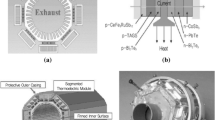Abstract
Currently, automotive exhaust-based thermoelectric generators (AETEGs) are a hot topic in energy recovery. In order to investigate the influence of coolant flow rate, coolant flow direction and cooling unit arrangement in the AETEG, a thermoelectric generator (TEG) model and a related test bench are constructed. Water cooling is adopted in this study. Due to the non-uniformity of the surface temperature of the heat source, the coolant flow direction would affect the output performance of the TEG. Changing the volumetric flow rate of coolant can increase the output power of multi-modules connected in series or/and parallel as it can improve the temperature uniformity of the cooling unit. Since the temperature uniformity of the cooling unit has a strong influence on the output power, two cooling units are connected in series or parallel to research the effect of cooling unit arrangements on the maximum output power of the TEG. Experimental and theoretical analyses reveal that the net output power is generally higher with cooling units connected in parallel than cooling units connected in series in the cooling system with two cooling units.
Similar content being viewed by others
References
F. Stabler, DARPA/ONR/DOE High Efficiency Thermoelectric Workshop (2002), p. 1.
K.M. Saqr and M.N. Musa, Therm. Sci. 13, 165 (2009).
S. Kumar, S.D. Heister, X.F. Xu, J.R. Salvador, and G.P. Meisner, J. Electron. Mater. 42, 944 (2013).
Y.D. Deng, X. Liu, S. Chen, and N.Q. Tong, J. Electron. Mater. 42, 1634 (2012).
X. Liu, C.G. Yu, S. Chen, Y.P. Wang, and C.Q. Su, J. Electron. Mater. 43, 2218 (2014).
Y.P. Wang, C. Wu, Z.B. Tang, X. Yang, Y.D. Deng, and C.Q. Su, J. Electron. Mater. 44, 1724 (2015).
C. Liu, Y.D. Deng, X.Y. Wang, X. Liu, Y.P. Wang, and C.Q. Su, Appl. Therm. Eng. 108, 916 (2016).
Y.P. Wang, S. Li, Y.D. Deng, and C.Q. Su, J. Electron. Mater. 45, 1792 (2016).
A. Rezania, L.A. Rosendahl, and S.J. Andreasen, Int. Commun. Heat Mass 39, 1054 (2012).
J.W. Qiang, C.G. Yu, Y.D. Deng, C.Q. Su, Y.P. Wang, and X.H. Yuan, J. Electron. Mater. 45, 1679 (2016).
Y.D. Deng, X. Liu, S. Chen, H.B. Xing, and C.Q. Su, J. Electron. Mater. 43, 1815 (2013).
Q. Du, H. Diao, Z. Niu, G. Zhang, G. Shu, and K. Jiao, Energy Convers. Manag. 101, 9 (2015).
W.H. Chen, C.Y. Liao, C.I. Hung, and W.L. Huang, Energy 45, 874 (2012).
C.Q. Su, M. Xu, W.S. Wang, Y.D. Deng, X. Liu, and Z.B. Tang, J. Electron. Mater. 44, 1876 (2015).
Y.D. Deng, S.J. Zheng, C.Q. Su, X.H. Yuan, C.G. Yu, and Y.P. Wang, J. Electron. Mater. 45, 1 (2015).
Y.P. Wang, S. Li, Y.F. Zhang, X. Yang, Y.D. Deng, and C.Q. Su, Energy Convers. Manag. 126, 266 (2016).
Acknowledgements
This work was funded by Grant No. 2013CB632505 from the National Basic Research Program of China (973 Program).
Author information
Authors and Affiliations
Corresponding author
Rights and permissions
About this article
Cite this article
Su, C.Q., Zhu, D.C., Deng, Y.D. et al. Effect of Cooling Units on the Performance of an Automotive Exhaust-Based Thermoelectric Generator. J. Electron. Mater. 46, 2822–2831 (2017). https://doi.org/10.1007/s11664-016-4989-0
Received:
Accepted:
Published:
Issue Date:
DOI: https://doi.org/10.1007/s11664-016-4989-0



